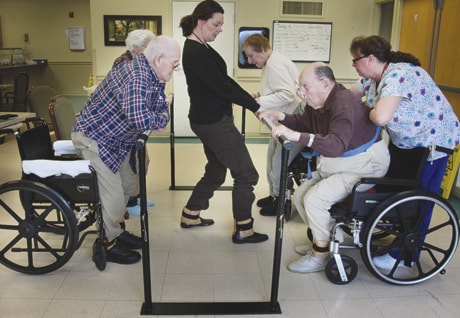Rolling his wheelchair down the hall after exercise class recently, Herman Kapla paused to assess the results of the vigorous new workout program at the St. Paul, Minn., nursing home where he lives.
“Oh, I don’t know. I’m pretty much the same,” the 98-year-old said. “Well, except I can stand up now.”
In 13 Minnesota nursing homes run by Duluth-based Benedictine Health System, nurses and aides are expressing amazement at changes they see in more than 650 residents who are stretching, standing, squatting and lifting weights in an experimental program designed to reduce dangerous falls.
The ambitious project, launched in October and funded in part by US$3 million in state assistance, aims to reduce one of the biggest health risks to nursing-home residents. More than 1,000 Minnesotans died from falls in nursing homes from 2002 to 2008, according to a 2009 Minneapolis Star Tribune analysis. In addition, falls can cause painful and debilitating injuries, leading to tens of millions of dollars annually in hospital costs.
“Our goal is to reduce falls 10 percent — really important because falls are so dangerous for older people,” said Kelly Judd, director of therapy for Benedictine, who developed the program and secured the state assistance. “But really, this is about more than falls. What we’re doing is improving the quality of life for people, mentally and physically. The stories are heartwarming.”
Like the woman who has graduated from a wheelchair to a walker. Or the resident who said his son wondered what he was up to because his grip while shaking hands was so much stronger.
And there’s Kapla, a retired miner from Michigan who attends sessions at Cerenity Care Center-Marian St. Paul.
“It’s work sometimes, but it makes you feel a little more in control,” he said. “By my age, you sort of expect to keep losing your friends and abilities. With this class, it’s kind of the reverse.”
On average, one nursing-home resident in Minnesota dies every two days from a fall, and many homes are trying to do something about it. They must assess each resident for risk of falling, and some have programs to refine their assessments or build strength among those at risk.
The Benedictine program takes that one step further, with a wellness exercise program for all residents willing to participate. About two-thirds have volunteered so far, many with mild dementia.
The exercises were developed by physiologist Shane Paulson of Osakis, Minn., after working with residents at other nursing homes. He trained home staff to lead exercises he prescribes for each participant after testing strength and flexibility.
If necessary, Paulson and employee Patrick Ayres change — and usually increase — the weights or repetitions.
Judd’s staff proceeds carefully because, perversely, the number of falls may actually rise at first. “We have to stay very alert,” she said, as residents get stronger and are more able to stand, walk and fall.
Yet the results are encouraging.
Anne Kolar, co-director of recreation and wellness at Cerenity Marian, noted:
“Many of the participants say they don’t see much change, but we do, and so do their families. Depression levels are down, self-confidence is up and many residents are more sociable.”
Part of the state grant — an increase for two years in the payment rate for residents on Medicaid — is for exercise machines with “smart cards” that guide users through prescribed exercises.
Once firmly established in the nursing homes, the program will be offered to those in attached assisted-living and independent-living apartments at the 13 sites, as well as to employees. Participating Benedictine homes are in Duluth, New Brighton, Ada, New London, Rochester, Red Wing, Shakopee, Eveleth, Mora, Crookston, St. Paul and South St. Paul.
Cooling off after straining to stand for two minutes at the end of his workout, Kapla said he’s pleased that employees may join in — another reason to keep pumping iron.
“I like to set a good example for these young people,” he said. “Sometimes they need encouragement.”
